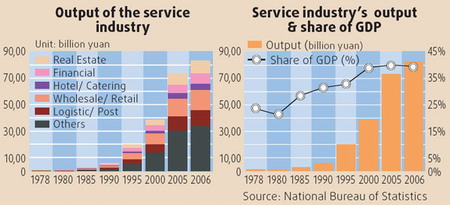
|
BIZCHINA> Wen's Lens
 |
|
Related
Market growth
By You Nuo (China Daily)
Updated: 2008-05-05 17:14
  This was the beginning of an ordinary day in Beijing in 1984 when private vendors and their logistical contractors (those pushing tricycles) were ready to enter a market before it was open to customers. At the time, one phenomenon in all urban residential quarters in China was the so-called emerging "free markets" - a name that might sound too grand or philosophical to be a place where you could spend half a yuan to buy some fresh spinach or a pancake. People from other countries would simply call it a neighborhood market, grocery or bazaar. The name did sound much more significant than the immediate reality - a shabby, often unsheltered, marketplace which generated a total of several hundred yuan worth of daily sales for all vendors. It would not be generating much more considering how much all the tricycles could move in sacks and baskets. Small and makeshift as these businesses were, however, their very existence had been unlikely just a few years ago. Individuals trading items for a profit, especially without approval from administrative officials at a certain level of administration, would be subject to public criticism and reprimands, if not criminal charges. Through the most outrageous years of the 1960s and 70s, going for "free market" was regarded as a daring challenge to the notion of the "planned economy". The latter was deemed to be "purer" than the former. So when economic reforms began, no attempts were made to make the economic system "pure" by any ideological standard and people triumphantly called where they would gather and trade a "free market". Much of China today is a result of such changes that seemed as small as the sacks and baskets of the 1980s. That is why today's mammoth flourishing economy owes a debt to the old grass-roots "free market". Dominating the landscape of urban retail business, like in many other countries, are the supermarkets and glittering department stores. In a shopping mall like the one in the color picture - the first Wal-Mart in Beijing - an individual shopper's single bill could exceed the total revenue of a "free market" of the 1980s. In fact, from the beginning of its market-oriented reform to the middle of the 2000s, China's retail business (in terms of retail sales of consumer goods) saw a growth of 49-fold. The nation's total retail volume was 155.8 billion yuan ($22.68 billion) in 1978, as compared with 7.64 trillion yuan in 2006. Also in 2006, the retail industry alone, not including hospitality and catering, created at least 3.1 million jobs. But when combined, the three industries amounted to more than 8.5 million jobs.

(For more biz stories, please visit Industries)
|
主站蜘蛛池模板: 石首市| 大埔区| 本溪| 镇远县| 屏东市| 桦川县| 肥城市| 梓潼县| 织金县| 泊头市| 顺平县| 辽宁省| 綦江县| 马龙县| 东兴市| 天柱县| 云梦县| 高唐县| 奉新县| 湖北省| 盐津县| 东阿县| 鄂温| 梅州市| 泸州市| 宜都市| 庄河市| 福泉市| 穆棱市| 阿图什市| 福贡县| 青冈县| 金塔县| 诸城市| 高清| 犍为县| 宁海县| 桐乡市| 罗源县| 大庆市| 万全县|